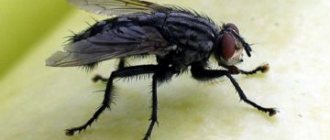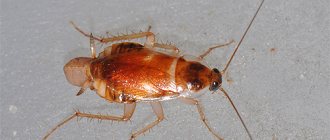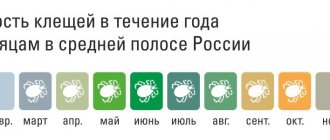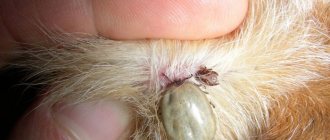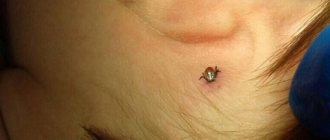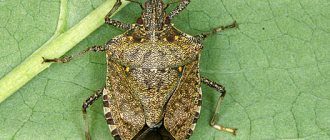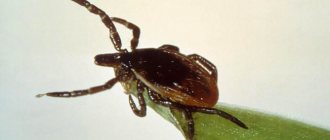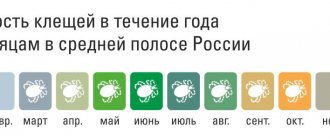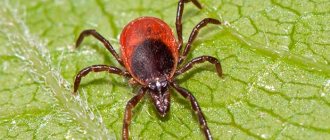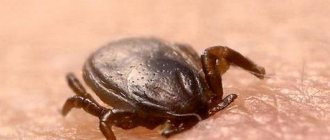The ixodid tick superfamily, notorious for tick-borne encephalitis and borreliosis, consists of 3 families. The most numerous of them: Ixodidae, is divided into 6 subfamilies. One of them, Amblyomminae, includes the genus Dermacentora, which has even received the common name “American dog tick.” The dermacentor mite is more common in the Nearctic zone, that is, the main species live in North America. But they are found not only on the North American continent. This is a race of cosmopolitans. There are representatives of it even in Australia, which has long been isolated from the rest of the continents. But in the neotropical zone and Australia, the species composition of this genus is limited.
A bit of Wikipedia
Ticks are animals belonging to the class of arachnids. To date, more than 53 thousand species have been identified and described , including microscopic mites that cannot be detected with the naked eye. This type of insect is found in all corners of the planet, even in Antarctica.
Interesting fact! In Antarctica, ticks parasitize penguins and local bird species. Another proof that abnormally low temperatures are not terrible for this type of arachnid.
Encephalitis tick
Not all types of ticks are dangerous to humans, only some of them. The most dangerous is considered to be a whole order of arachnids called Ixodida . They are responsible for the spread of encephalitis, tick-borne borreliosis (Lyme disease) and other infectious diseases. They are the ones you should be wary of and avoid meeting with them in every possible way.
Where are ticks common?
Pasture varieties of ticks are widely distributed in most agricultural southern regions of Russia and neighboring countries. They are also found in the lands of the North American continent and even Australia. Where this mite first appeared remains a mystery. However, like other pests, their spread occurs through:
- movement of eggs in the soil,
- surface migration on agricultural machinery and livestock skins,
- through intercontinental transport of plant material.
Some researchers believe that tick eggs are capable of traveling long distances in the wind.
Types of ixodid ticks dangerous to humans
Correctly identifying the type of tick is an important and useful skill, especially for those who live in potentially dangerous regions of Russia. Identification of the species allows us to understand what infections the tick can carry, which will simplify the work of doctors and increase the chances of stopping the disease at the initial stage of development.
Black-legged tick
Black-legged tick (Ixodes scapularis)
First on the list of dangerous species is the black-legged tick (also known as Ixodes scapularis). It lives mainly in Europe and on the southeastern coast of North America. Sometimes it is found in the European part of the Russian Federation, but rarely.
Can carry many dangerous infectious diseases, including Lyme Disease. There are also cases of infection with granulocytic anaplasmosis, and less commonly with babesiosis. An example of what a tick looks like (photo).
The bite of the black-legged tick is invisible. The victim does not feel the moment of the bite itself, nor the feeding process . Usually, it actively drinks blood for 3-5 days, and then falls off on its own, noticeably increasing in size (up to 10-12 mm).
Dog tick
Dog tick (Ixodes ricinus)
Dog tick , also known as Ixodes ricinus, is a subspecies of the Ixodes family that is a carrier of severe infectious diseases. The most common are individuals infected with tick-borne encephalitis and borreliosis; less commonly, dog ticks carry infections such as Marseilles fever and tularemia.
Distributed in the European region and Asian countries. In smaller quantities in Africa and North America (USA). The color and size of the individual is not much different from other representatives of the order Ixodidae, except for a small dark spot (or several) on the back.
Important! There is a myth that dog ticks only bite dogs. This is a misconception that arose primarily due to the name of the species. Dog ticks bite both animals and humans.
Taiga tick
The most common and dangerous species of ixodid in Russia is the taiga tick (lat. Ixodes persulcatus), also known as the encephalitis tick. It is he who most often becomes the culprit of mass infections with encephalitis , which are recorded annually in various regions of the Russian Federation. It can also carry other dangerous infections characteristic of this species.
Female and male taiga tick (Ixodes persulcatus) waiting for their next victim
The female has a standard red body color and black limbs. The male is monochromatic, dark, closer to brown. They usually sit on the grass waiting for prey. Distributed throughout Russia. Particularly active in regions separated from the capital and the Far East, in particular.
Interesting! Many are sure that ticks can jump and climb trees and then fall (bend down) on the victim. But this is just a myth. They usually do not rise higher than one meter above the ground and prefer to sit in tall grass and various bushes. More details on Yandex.Q.
Meadow tick
Meadow mite (Dermacentor reticulatus)
One of the dangerous subspecies of ixodids is Dermacentor . There are two types of danger: meadow and pasture ticks. The meadow tick (Dermacentor reticulatus) is a typical inhabitant of open meadows and pastures, forest edges and clearings. Widely distributed in Siberia, Europe and the European part of the Russian Federation. After a tick bite, already familiar diseases can occur: encephalitis, Lyme disease and many others. What does a tick look like (photo).
This species is popularly called brown ticks because of its characteristic color. Individuals of this species are slightly larger than their counterparts, so they are better visible in the grass. Appears several weeks earlier than the taiga tick , since it is more resistant to low temperatures.
Pasture mite
Grass mite (Dermacentor marginatus)
A “close relative” of the meadow tick is the pasture tick (Dermacentor marginatus) . Externally, these two species are very similar. Only scientists involved in the search for new species and classification of arachnids will be able to find differences in appearance.
In addition to habitat preferences (meadows, pastures, forest clearings), it carries the most dangerous diseases, including:
- tick-borne encephalitis;
- Omsk hemorrhagic fever;
- rickettsiosis;
- dermacentorosis;
- Crimean-Congo hemorrhagic fever;
- can also transmit pathogens of brucellosis;
- tuleramii;
- Key fever;
- and even plague.
It is noteworthy that the tick first makes a couple of test bites, and only then sticks to the victim for several days.
Ticks of the Argasidae family
Agras mite (Argasidae)
Another type of tick from the order Ixodida is agras ticks (Argasidae) . They have significant external differences from ixodids. In particular, their shell is soft and the color is dull brown.
The danger to humans is mainly infectious diseases: tick-borne relapsing fever and borreliosis. They live mainly in caves, burrows, and various crevices . They hunt at night, but can bite a person during the day in the shade.
Important clarification! If you are bitten by a tick, this does not mean that you will definitely get one of the infectious diseases. You just need to remember that every tick bite is a big risk. In approximately 90% of cases, people are bitten by “clean” ticks, that is, uninfected ones.
Both the table and the house
Having clung to the host, ticks actively search for a suitable place to attach, preferably where it is more difficult for the host to get rid of them, for example, on the ears and head of rodents. On hedgehogs with their spines, mites are more evenly distributed, but on primates there are practically no mites. In regions with a dry and hot climate, ticks more often stick to the lower part of the body, protected from the sun. They can even be found in the mouths of elephants and in the nostrils of hippos and camels.
Ticks attach themselves to people in a variety of places: in the armpits, less often on the chest, abdomen, arms, buttocks and legs, as well as on the head, especially in children.
Ticks attach to the host's skin with their mouth parts, cut through it and use their proboscis to suck out blood, inflammatory infiltrate and tissue dissolution products, alternating this process with the introduction of saliva into the wound.
A sucked ixodid tick works like a well-oiled pump: per minute it makes from 2 to 60 acts of suction, strictly separated by acts of injecting saliva. Left
- an adult female ixodid tick feeding on a horse (after Estrada-Pena et al., 2017).
On the right
is the “head” of the taiga tick (view from the dorsal side). Scanning electron microscope. Photo by S. Tkachev (IBFM SB RAS, Novosibirsk)
Ixodid ticks feed slowly: larvae feed for 3–5 days, females for 5–15 days. During feeding, their body weight increases by one or two orders of magnitude: females of the largest species can absorb up to 8–10 ml of blood!
After finishing feeding, the larvae and nymphs fall away from the host and molt, moving to the next stage of development. In adult ticks, feeding is associated with reproduction. Partners, as a rule, meet on their host - hungry male and female ticks are not able to mate, with the exception of ticks of the genus Ixodes
. The male can remain on the host for several months and during this time fertilize several dozen females. The female mates only once, after which she quickly gains weight, falls away from the owner and after some time (from several days to months) lays eggs (from 800 to 20,000 depending on the species), after which she dies (Balashov, 1998; Biology of Ticks, 2014).
In most cases, the development of ixodid ticks occurs with a change of host at each stage of the life cycle. Their feeders are birds, reptiles and, first of all, mammals, especially rodents. Thus, the taiga tick parasitizes approximately 170 species of birds, 100 species of mammals and several species of reptiles. As a rule, small animals moving in the lower tiers are attacked by larvae and nymphs, and large animals are attacked by adult ticks (Balashov, 1998; Biology of Ticks, 2014).
The life cycle of ticks is complex. The eggs laid by the female hatch into larvae (still six-legged), which after molting turn into nymphs, and the nymphs into adults, called adults. The duration of the life cycle for different types of ixodid ticks can range from one to six or more seasons (years). At each stage of the cycle, the tick must once feed on blood, with the larva, nymph and adult feeding on different animal hosts. The larva drinks the blood of a small animal (rodent or bird). The nymph must find and attack a larger animal (squirrel, hedgehog, hare). The adult tick feeds on other, even larger animals, such as elk or deer. However, some species of ticks have adapted to carry out a full development cycle on one host animal, which is left only by the female who has drunk blood
What ticks are found in Russia, Ukraine and Belarus
In our latitudes there are most taiga ticks, less black-legged ticks. Individuals of the dermacentor species (meadow and pasture mites) are also often found. In the southern regions you can find a couple of agras species.
In Russia, ticks are distributed almost throughout the entire territory, but infected individuals are found in the central, eastern and northern regions . Especially many cases of encephalitis infection are recorded in the Tomsk, Sverdlovsk, Kurgan and Tyumen regions, as well as in the Altai Mountains and Buryatia.
Habitat area of encephalitis ticks
As for Ukraine, infected ticks are more common in the central regions, less often in the western and eastern regions. Approximately the same picture is observed in Belarus.
Types of dermacentors
Ticks of the genus Dermacentor are the most numerous of the entire Ixodid family. Only a few species have been well studied:
- winter tick (Dermacentor albipictus);
- Rocky Mountain wood mite (Dermacentor andersoni);
- American Dog/Tree (Dermacentor variabilis);
- African elephant (Dermacentor circumguttatus);
- Indian (Dermacentor auratus);
- meadow (Dermacentor reticulatus)
- pasture (Dermacentor marginatus).
On a note!
Mites of the genus Dermacentorus have very different life cycles and host numbers. But all these parasites are carriers of dangerous diseases.
How does a tick get to a person?
Most species of ticks have extremely poor vision, with which they can only distinguish shadows. No images, colors or other privileges available to a person. However, evolution has awarded these insects with a much more formidable weapon - hypersensitivity.
They respond well to the slightest changes in temperature, movement, various odors (including those of humans), changes in humidity, and are able to pick up vibrations. Usually, to find a victim, a tick climbs onto bushes or grass and freezes in anticipation, with its front legs spread wide.
Interesting fact! Sensors, located mainly on the legs of the tick, are able to detect the smell and movement of the animal (human) at a distance of 8-10 meters.
The most comfortable conditions for living and hunting are forests with tall grass, and less often fields . As soon as the victim approaches the tick, it will immediately grab onto the person’s clothing, skin or hair. As for the ability to cling, ticks have no equal.
Next, the tick looks for a place to bite, choosing mainly areas with thinner skin: on the neck, groin, behind the ear, etc.
Biological characteristics of the insect
The pasture mite, or clover mite, entomologically belongs to the Bryobia family. These insects have relatively recently been identified as pests of winter crops and pastures in the southern parts of our country. This mite was first reported in the early 1900s, but has only been actively studied and controlled in the last decade, as the insects were identified as pests capable of causing significant damage in crop production.
It is worth noting that control of parasites is complicated by the large number of tick species, as well as their small size and lack of suitable morphological characteristics, which makes identification a rather difficult process.
In Russia, there are at least seven different Bryobia species living among wide expanses of agricultural land and pastures.
Of these seven types, three are the most common. It is against them that a purposeful struggle must be waged.
First signs of a tick bite
As already mentioned, a person does not feel the moment of a tick bite, nor how it drinks blood for several days, gradually swelling. The reason is a special substance that has anesthetic properties, which the tick injects at the time of the bite.
Unfortunately, after a bite there are practically no signs on the human body. Only after 2-3 days does redness and a red circle characteristic of a tick bite appear at the site of the bite. On the last day of the “meal” the bite site changes color to light yellow.
Therefore, it is extremely important to inspect the body for ticks after going to the forest or park. If you live in a potentially dangerous region, it is worth following basic safety precautions, since the best treatment for a tick bite is the absence of a bite itself.
Ways to fight
Individual protective measures against dermacentras are the same as protective measures against ixodids. When going for a walk in the forest, you need to wear special clothes that will not allow bloodsuckers to get to your body. Animals are protected with the help of acaricidal preparations for dogs and products for cats, which are equally effective on both dermacents and ixodids.
When returning from the forest, the body is carefully examined. The attached ticks of all genera and families are carefully removed, placed in a small container and submitted for analysis.
How to remove a tick (Video)
Before moving on to methods for removing ticks, here is a small list of what should never be done:
- Do not pick up a tick with your bare hands . Always use medical gloves; if not possible, use a bag.
- If someone advised you to douse a tick with gasoline, vodka, or cover it with Vaseline, do not listen! There is a myth that if you block the supply of oxygen, the tick will come out on its own; this is a dangerous misconception. The tick won't come out. But injecting saliva, rich in encephalitis pathogens, into the blood is easy.
- Do not press on the tick or pull it out using the usual method. The problem is that with such actions, the tick will most likely inject saliva into the blood, which may be infected.
The best advice we can give if you are bitten by a tick is to go to the nearest hospital immediately . There, the tick will be properly removed, the wound will be treated, and the insect will be sent for analysis to identify possible infections. If any disease is detected, it is much easier to treat it in the initial stages.
But if it is not possible to go to the hospital, then you should use one of the methods for properly removing a tick.
The first method is using special tweezers, which you can buy in advance.
The second method (field) of removing a tick is using a thread.
Removing a tick with a thread (photo)
Important! After fixing the tick with tweezers or thread, you need to unscrew it! Do not pull, do not press. Please exercise caution and patience.
Reproduction
Considering the large number of species, when going out into nature, a person must definitely think through safety measures and the seriousness of the consequences that a tick on the body can lead to. The photo presented below allows us to judge the volume of blood that the female needs to consume to increase from a few millimeters to similar sizes.
After the female is completely satiated, she falls to the ground and, having selected a suitable shelter for herself, begins laying eggs. In this case, fertilization of females occurs even during the period of saturation on the host’s body. Typically, laying is done in burrows, sand, fallen leaves, or in buildings where farm animals are kept. This place is ideal not only for its temperature characteristics, but also allows newly hatched ticks to gain quick access to food, since the larvae are born extremely hungry.
How dangerous are ticks for humans?
As mentioned above, a tick bite can trigger the development of various infectious diseases. Some diseases are more dangerous and can even lead to death or disability. Others are not as dangerous, but still require medical treatment using appropriate medications.
Tick-borne encephalitis
The worst thing that can happen to a person who is bitten by a tick is infection with tick-borne encephalitis . This is a dangerous disease that, if not treated appropriately and promptly, can lead to death. Sometimes the spread of infection is limited by the development of pathologies leading to disability.
Tick-borne encephalitis infection affects the gray matter of the human brain. Often the spinal cord membrane is additionally damaged, which can lead to partial or complete paralysis. These disorders can lead to difficult-to-reverse psychiatric and neurological complications. If treatment is not started, the disease leads to death.
The most dangerous type is considered to be tick-borne encephalitis, which is common in Siberia and the Far East . Mortality statistics from this type of infection are higher than from the European type of tick-borne encephalitis.
The first symptoms of the disease may appear after 10-14 days. As a rule, after such a period, doctors have to deal with the consequences, since within two weeks the disease completely takes over the human body.
For emergency prevention of tick-borne encephalitis in the first 24-72 hours after a bite, immunoglobulin is used . If you do not take an immunoglobulin tablet in the first three days, encephalitis begins to develop along with complications. Antiviral medications are often used after 72 hours after a tick bite, but their effectiveness has not been clinically proven.
Lyme disease (tick-borne borreliosis)
Tick-borne borreliosis is the most common disease that is transmitted to humans after the bite of an infected tick. The causative agents are spiral bacteria of the genus Borrelia. The number of cases of infection is 3-4 times higher than in the case of encephalitis. The danger of borreliosis lies in the secretive and asymptomatic course of the disease.
In 80% of cases, the symptoms of tick-borne borreliosis are mild and may be limited to:
- general fatigue;
- headaches of moderate intensity;
- sometimes there is a slight increase in temperature;
- less often fever;
- A rash may appear at the site of the bite.
However, when infected with borreliosis, there is one unique symptom that is difficult to ignore - erythema migrans , which can be chronic. Until the 80s of the last century, erythema migrans was considered a separate disease, and dermatologists were involved in its diagnosis and treatment. However, it later became clear that erythema migrans is one of the main symptoms of infection with the spirochete Borrelia burgdorferi.
Tick-borne erythema migrans
Erythema migrans looks like a ring-shaped redness (similar to a target), which within 2-6 weeks increases in diameter to 20-50 mm, and then disappears, and Lyme borreliosis disease passes into the next stage, at which the heart and nervous system begin to suffer system, less often the eyes and cartilaginous tissue of bones.
Tick-borne borreliosis can be of a non-erythematous form, which further aggravates the situation.
Lyme disease can develop in an acute form (up to 3 months) with obvious symptoms, and in a latent form (from 3 months). In any case, if spiral bacteria are not detected in time and drug treatment is not started - mainly with broad-spectrum antibiotics - the disease begins to penetrate the heart, cartilage tissue, central nervous system (CNS) and eyes.
The longer borreliosis is in the body, the higher the likelihood of disability , which develops against the background of extensive damage to the nervous system. Lyme disease is sometimes fatal. In the initial stages, the disease is easily treated with antibiotics. If the disease is in an advanced form, it is more difficult to treat, much more difficult.
Doxycycline is widely used for emergency prevention of tick-borne borreliosis. Typically, take one 200 mg doxycycline tablet within 72 hours of a tick bite. If you take the pill 3 days after the bite, there will be no effect.
Important! Doxycycline has pronounced side effects in the form of headaches, dizziness, confusion, seizures and others. Therefore, doctors do not recommend taking doxycycline on your own, especially in the field.
Monocytic ehrlichiosis
Ehrlichiosis is a whole group of vector-borne diseases with various symptoms and consequences for humans. Ehrlichiosis can be caught after a bite from a black-legged tick, meadow tick, or others. The area of distribution is all of Europe, Russia, the countries of the former CIS, the USA and some African countries, in particular Mali.
The incubation period of monocytic ehrlichiosis can range from 2-3 days to 3 weeks. Symptoms are similar to fever, and are expressed in such manifestations as:
- headache;
- heat and fever (38-39 degrees);
- chills;
- muscle pain;
- vomit;
- nausea;
- a rash may appear;
- anorexia;
- intoxication.
One of the common complications of monocytic ehrlichiosis is renal failure. This pathology develops if a person, after being bitten by an infected tick, does not begin appropriate conservative treatment. Also, when the disease is advanced, internal bleeding may develop in the lungs, stomach and gastrointestinal tract.
Diagnosing ehrlichiosis is difficult due to the fact that the disease is often asymptomatic , or can develop in conjunction with other diseases typical of a tick bite - tick-borne encephalitis, borreliosis and others. Ehrlichiosis is treated with tetracycline drugs: doxycycline, tetracycline, and less commonly levomecithin.
Babesiosis
Babesiosis mostly affects animals, mainly cattle, dogs and others. But among the 100 species of babesiosis pathogens, there are bacteria that cause babesiosis in humans , in particular, Babesia divergens.
Babesiosis is an invasive vector-borne disease that leads to the development of typical fever, anemia and jaundice. Possible damage to the heart, liver and kidneys.
Babesiosis is transmitted by several species of pasture ticks. The disease is widespread throughout Russia, but outbreaks are more often recorded in the southern regions of Siberia . Cattle, sheep, deer, and dogs are asymptomatic carriers of babesiosis, and ticks and small rodents act as spreaders of the disease. The tick first bites an infected animal, then a person, and if the bitten person has reduced immunity, babesiosis may develop.
Babesiosis usually responds well to drug treatment. The most effective medicines: piroplasmin, tiargen, ichtargan and others.
Hemorrhagic fevers
Hemorrhagic fevers are a group of acute viral febrile diseases transmitted from animals to humans, including through tick bites. These viruses have a common specific clinical picture, which is expressed in the following symptoms:
- general vascular damage;
- sudden increase in temperature, heat and fever;
- subcutaneous hemorrhages;
- leukopenia (decrease in the number of white blood cells);
- internal bleeding.
Hemorrhagic fever can be caused by various viruses, including the following viruses: Lassa, Sabia, Ebola, Guanarito and others, but if you look at this disease from the point of view of a tick as a carrier, then in our latitudes three types of fever are most often found.
Hemorrhagic fever with renal syndrome (HFRS)
Hemorrhagic nephrosonephritis has a set of symptoms standard for fever, which is complemented by the development of renal pathologies and pronounced intoxication. Often found in Asian and European countries, including Russia, Ukraine and Belarus.
The mechanism of transmission of the virus has not been studied for certain, but it is assumed that the main culprit in its spread is a tick of the genus Gamasidae. To a lesser extent - mice and rats. The incubation period ranges from 10 to 25 days, after which a person develops renal nephrosonephritis.
Omsk hemorrhagic fever
The first mass cases of infection with Omsk hemorrhagic fever were recorded in the 40s of the twentieth century. Natural foci of the spread of the virus were in the Omsk region, but several years after its appearance, foci of infection spread to other regions of the Russian Federation, including the Tyumen, Novosibirsk, Kurgan and Orenburg regions.
Small mammals (about thirty species) are called sources that carry Togaviridae arbovirus pathogens. At one time, the muskrat was responsible for the spread of Omsk hemorrhagic fever during its active hunting. The carriers of pathogens from infected mammals to humans are the ixodid ticks Dermacentor.
During the development of Omsk fever, in addition to the standard symptoms for this disease, vascular thrombosis , caused by a generalized increase in permeability, and perivascular infiltration are observed.
Against the background of Omsk fever, hemorrhages in the mucous membranes of the fallopian tubes, lungs and nasopharynx can be observed. Often recorded: facial hyperemia, conjunctiva of hard and soft gums. It is possible to develop pneumonia with simultaneous damage to the central nervous system (CNS).
The incubation period of Omsk fever lasts 3-14 days, after which the acute phase of the disease begins , characterized by a significant increase in temperature (39-40 degrees), nausea, vomiting, chills, general malaise, loss of strength, muscle pain and persistent pain (migraine). After 2-4 weeks, the fever goes away, and the body develops stable, long-term immunity to re-infection.
Crimean hemorrhagic fever
Cases of infection with Crimean hemorrhagic fever are rare and occur mainly in Crimea, and to a lesser extent in the Rostov region. Infections were also recorded in Tajikistan, Kyrgyzstan, Southern Kazakhstan, Turkmenistan and Uzbekistan. The ixodid tick Hyalomma is responsible for the spread of pathogens (Photo).
Ixodid tick Hyalomma
The incubation period of fever is short - only 3-7 days , after which the disease enters the acute phase with pronounced symptoms characteristic of hemorrhagic fevers.
Larval development
It is noteworthy that the newly hatched larva does not have genitals at birth, and only after a few days of continuous feeding, after the individual has molted, it transforms into a nymph, which in size is very similar to an adult tick.
The pasture tick, whose life cycle has characteristic features and is quite complex, includes several stages of transformation: from larvae to adult. It needs a minimum amount of time to fully develop. The speed of its development directly depends on climatic conditions and the timely finding by the larva of a constant source of food for this period. The larva feeds for about three days, after which it undergoes its first moult, after which it transforms into a nymph.
The pasture tick remains in the nymph stage for about a week, after which another molt occurs, as a result of which the individual transforms into an adult, and the development cycle of the pasture tick is completed.
First aid for a tick bite
First aid for a tick bite involves timely detection and proper removal of the parasite . If you remove a tick correctly using the instructions described above, the likelihood of contracting encephalitis, borreliosis and other viral diseases is reduced to almost zero, even if the insect was infected.
Virologists do not recommend emergency prevention, especially in field conditions far from medical centers. The problem is the pronounced side effects of emergency prophylactic drugs. Taking immunoglobulin (tick-borne encephalitis) or doxycycline (borreliosis), a person feels general fatigue, nausea, severe muscle pain and headaches, even fainting. Convulsions may occur.
Therefore, the best thing a person who has been bitten by a tick can do is to remove it correctly and immediately go to the nearest medical center. point, taking with you the extracted parasite . Doctors will take the insect for examination and, based on the analysis results, will be able to determine what viruses the tick was infected with. This approach gives the most effective results because:
- Doctors learn the patient’s possible diagnosis at an early stage, which greatly influences the effectiveness of future treatment. It is much easier to fight viruses in the early stages .
- A person who goes to a medical facility is already under the supervision of doctors.
- Ticks often carry multiple viruses at the same time. Laboratory studies of the insect will allow us to identify all the viruses that the tick carries and develop relevant drug treatment.
Important! Every tick bite is potentially dangerous. Therefore, it is better to go to the hospital. This is especially true for residents of areas endemic for tick-borne encephalitis and borreliosis.
Chemical pest control
Chemicals are the most commonly used method in controlling these pests. Today, several pesticides have been developed that are registered specifically to control the population of pests such as ticks. These chemicals are only effective against active stages of insects - they do not kill their eggs.
Differences in tolerance levels between species complicate control. At least one species of mite may have high natural resistance to a number of pesticides registered, for example, against terrestrial mites.
Pesticides with long residual effects can be used as bare soil treatments. These treatments can be applied before or during planting to kill mite larvae and protect plants during the early seedling stage. If damage begins to appear on young crops, another course of treatment is applied three weeks after the first.
Preventive methods of protection
Prevention is the best way to protect yourself from tick-borne encephalitis, Lyme disease and other viral infections carried by ticks. There is a certain set of rules that should be followed if you do not want to become the next victim of this quiet inhabitant of our fields and forests.
Preventive methods of protection against tick bites:
- Do not wear open-toed shoes such as sandals, sandals or flip-flops.
- You should also avoid shorts and T-shirts. It is better to choose pants and outerwear with long sleeves .
- It wouldn’t hurt to tuck your pants into your sneakers/boots, or even better, into your socks.
- As for color, it is better to choose light-colored things, since small ticks are better visible on them.
- Cover your head and neck.
- You can use special mosquito nets . Today there are even fishnet suits on sale.
- Don't neglect repellents. You can treat both exposed parts of the body and things.
- Avoid tall and thick grass.
- You should not collect and take home forest flowers and herbs.
- When traveling for a long time, regularly inspect your clothing for ticks.
Remember, the best defense is not getting bitten by a tick. No bite, no problem!
Sexual differences in pasture ticks
The pasture tick, whose size in a hungry state rarely exceeds 6 mm, can increase up to 2 cm. Moreover, it can be distinguished from other varieties not only by its unique dimensions, but also by its appearance.
The upper part of their body is covered with a dense dorsal shield, by which the gender of an individual can be determined. In males it covers the entire upper part of the body, while in females and larvae at all stages of development it covers only the front part. In addition, females suck several times more blood than their own body weight, as a result of which they swell so much that they begin to resemble a large bean, while the male requires much smaller volumes of blood for normal functioning. It is noteworthy that females are much more often carriers of serious diseases, contributing to the emergence and maintenance of natural foci of viral infections.
Vaccination against tick-borne encephalitis
There are currently several vaccine preparations against tick-borne encephalitis on the market. For example, EnceVir (EnceVir) made in Russia, or Encepur (Germany) , which is produced for both adults and children.
Every major city has laboratories involved in the research of tick-borne viruses and preventive medical clinics. At this link you will find the addresses of such medical institutions in different cities and regions of the Russian Federation.
At the end of the article, I would like to repeat the common truth - if you are bitten by a tick, immediately go to the nearest hospital . This is not an empty call, it is a recommendation that can save your life. And don't forget about preventive methods of protection. After all, if there is no tick bite, there will be no consequences .
Post Views: 3,346
Pest identification
Pasture varieties are often mistakenly compared to other pests such as ground or blue oat mites. However, the clover mite is smaller, reaching only 0.75 mm in length as an adult. This species has a flat oval body and is dark gray, light orange or olive in color.
Adults have eight pale red-orange legs with a pair of elongated forelimbs.
It is these front legs that can help distinguish the pasture pest from other insects. Here you can find out what gamas mites look like.
The eggs are spherical and red in color. They measure about 0.15-0.25 mm in diameter and are located separately or in small groups covered with pollen. Newly hatched larvae are very small in size, bright orange-red in color and have six legs. The larval stage is then followed by two nymphal stages, where the tick acquires eight legs and resembles adults.
The male tick is quite easily distinguished from the females by its much smaller body size and extremely long front legs, which are up to two times larger than the dimensions of the insect.
Medical significance
Pasture ticks are dangerous for spreading various diseases.
- Lyme disease or borreliosis;
- tick-borne encephalitis;
- tularemia;
- ehrlichiosis;
- babesiosis;
- fever;
- relapsing fever;
- helminthic infestation.
Important!
The most dangerous infections are borreliosis and tick-borne encephalitis. Infection occurs through the bite of an infected pasture tick. The incubation period lasts on average 14 days. The first symptoms are similar to the flu. It begins acutely with fever, headache, muscle aches, photophobia, etc.
The acute phase of borreliosis, tick-borne encephalitis lasts about 10 days. After this, either the disease recedes, immunity is developed, or continues to progress. The next exacerbation occurs within a month, the manifestations are stronger and longer lasting. In the absence of qualified therapy, paralysis, paresis, disability, dementia, visual impairment, hearing impairment, and death occur. Tick-borne infections affect the brain, central nervous system, and muscles.
